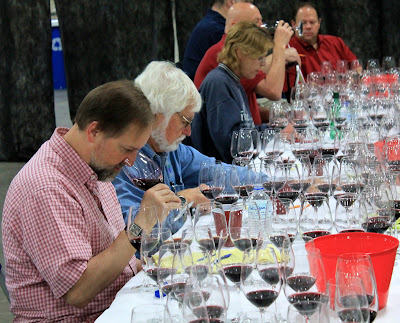I
eat for a living. As the restaurant reviewer for a Santa Barbara newspaper for seven years I eat…a lot. I get to travel and sample foods from various
countries and judge at food and wine events, so I’m always near food, thinking
about food, eating food or wondering about my next food. About 40 restaurants opened in 2013 and many are forgettable; many are good, but only a few
fill a void with unique, creative food, service and ambience. So listed in alphabetical
order are my favorite spots which opened in Santa Barbara for 2013. Check them
out!
Georgia’s Smokehouse Here’s the truth – Santa Barbara sucks for BBQ, until this great food truck rolled into our lives. Stunningly tender ribs, pulled pork and spot on sauces proves that a food truck
can be flat out awesome. Try the Bacon and Cheddar Hush Puppies, delightfully crisp deep-fried
balls of dough mixed with cheese and bacon and topped with sea salt, seriously that’s a no-brainer.
Their Smoked Burger is topped with whiskey-caramelized onions and roasted tomatoes with
clean and focused flavors and a hint of sweetness. The Smoked Baby Back Ribs are wonderfully
fall-off-the-bone tender ribs coated with a tangy vinegar-tomato sauce that has great citrus and heat.
805/845-4854, GEORGIA'S SMOKEHOUSE
 |
| At the Paso Robles Winemaker's Cookoff judging competition |
Paloma Mexican food goes where
it should have gone years ago – out of the dull realm of tacos and beans, and
into seasonal South American dishes with spicy sauces and real flavor. You must
order the Chile en Nogada, a Pasilla chile stuffed with walnuts, pine nuts,
ground beef, peaches, spices and topped with a creamy, slightly sweet sauce and
dotted with pomegranate seeds. A seasonal dish from Puebla Mexico, this offers a
great balance of heat and texture. The Enchiladas Paloma is a shrimp and cheese
enchilada topped with a creamy chipotle sauce that actually has a potent roasted
smoky quality the way chipotle is supposed to be. Oh, and there are 100
tequila’s for your consideration…woo hoo!
5764
Calle Real, Goleta, 805/681-0766
Monday
- Friday 11 a.m. to 10 p.m., Saturday & Sunday 9 a.m. to 10 p.m. PALOMA
 |
| The real deal- Greek salad in Crete. |
Sama
Sama
Not familiar with Indonesian food? Great – here’s your intro. They use rotating
local farms where they get their vegetables. The foods are simple and rustic
but loaded with flavor and finesse including the Tempe Rice Bowl of sweet soy
glazed crispy tempe, mixed with coconut rice and topped with a gado-gado salad
of thin sliced cucumber, zucchini then mixed with a peanut dressing. Hands
down, one of the best vegetarian dishes in town. The Nasi Goreng is fried rice
mixed with diced carrots, celery, garlic and broccolini with a fried egg on top
and then dusted with green onion, and served with shrimp crackers. Uncomplicated
but very gratifying food. 1208
State St., Santa Barbara, 805/965-4566
Tuesday
- Friday 11:30 a.m. - 2 p.m., & 5:30-10 p.m., Saturday
5:30-10 p.m., Sunday 10:30 a.m. - 3 p.m. SAMA SAMA
Seven is located in the hip,
new, trendy Funk Zone and this under the radar spot, really a bar with killer
food, is as unpretentious as it is hard to find. No address, no signage – they
think it’s a cool like that. It’s actually annoying, but forgive that (and the
weak service) and go for Chicken and Waffles with infused maple in the chicken,
their Cali Slaw (an awesome riff on Cole Slaw featuring herbs du Provence, or
any of their sandwiches (named after the seven deadly sins) and yes, their
mouthwatering pulled pork sliders. Simple bar foods done exceptionally well! They
have a back patio, exposed brick interior, some cool cocktails and rotating
art. 224
St. Helena, Santa Barbara, 805/845-0377, Monday
- Friday 5 p.m. - 1 a.m., Saturday
& Sunday Noon - 1 a.m. SEVEN
The
Lark
is named for an overnight Pullman train that serviced Santa Barbara for 60
years. Their Caramelized Cauliflower Gratin is an instant classic with texture,
heat and spice. Gruyere cheese is mixed with preserved lemon, chili flake,
bacon, breadcrumbs and cauliflower, then baked - absurdly wonderful. The Roasted
Mary’s Chicken is brined then air-dried making it extraordinarily moist, served
with brown butter polenta, butternut squash, and a maple Sherry chicken juice. Crispy
Brussels Sprouts are a mix of Medjool date, sesame, lime, and garum for a
savory element. The result is a dish of great balance and texture, with a sweet
note as a counterpoint to the vegetal sprouts.
131
Anacapa, Santa Barbara, 805/284-0370,
Tuesday
- Thursday, & Sunday 5-10 p.m., Friday
& Saturday 5-11 p.m. THE LARK
 |
| Me and the Mrs chowing down in Innsbruck, Austria |
Toma sits in the former Eladio’s spot
near the harbor and this is an absolute gem. Love, love, love the Tuna Cones which are comprised of diced ahi sashimi, ginger, sesame,
soy, chile, and chives stuffed into a crisp sesame seed cone - think of this as
an ice cream cone for adults. Also excellent are their pasta dishes, grilled
romaine salad, and braised short ribs, frankly it doesn’t matter, it’s all so
damn good with exceptional service – a shortcoming of far too many restaurants
everywhere. 324
W. Cabrillo Blvd., Santa Barbara, 805/962-0777
Nightly
5-10 p.m. TOMA
And be sure to read my weekly reviews every single Friday in the Santa Barbara News-Press to see what's what in the culinary world here. I cover everything from high-end to holes-in-the-wall.
And be sure to read my weekly reviews every single Friday in the Santa Barbara News-Press to see what's what in the culinary world here. I cover everything from high-end to holes-in-the-wall.



































